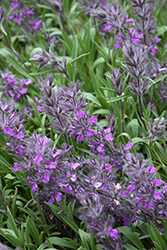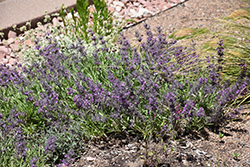It's all about ...
plants

Pink Cotton Lamb's Ear
Stachys lavandulifolia
Plant Height: 6 inches
Flower Height: 12 inches
Spacing: 18 inches
Sunlight:
![]()
![]()
Hardiness Zone: (annual)
Other Names: Wood Betony
Brand: Plant Select
Description:
This woody based perennial variety forms a dense carpet of grassy gray-green leaves; lavender to pink flowers on short, hairy spikes in late spring to early summer; fast growing, and drought tolerant once established; great for beds and borders
Ornamental Features
Pink Cotton Lamb's Ear features showy spikes of lavender flowers with pink overtones and dark brown calyces rising above the foliage from late spring to early summer. Its small tomentose grassy leaves remain grayish green in colour throughout the season. The dark red stems can be quite attractive.
Landscape Attributes
Pink Cotton Lamb's Ear is a dense herbaceous annual with a ground-hugging habit of growth. Its relatively fine texture sets it apart from other garden plants with less refined foliage.
This is a relatively low maintenance plant, and is best cleaned up in early spring before it resumes active growth for the season. It is a good choice for attracting bees and butterflies to your yard, but is not particularly attractive to deer who tend to leave it alone in favor of tastier treats. Gardeners should be aware of the following characteristic(s) that may warrant special consideration;
- Spreading
Pink Cotton Lamb's Ear is recommended for the following landscape applications;
- Mass Planting
- Border Edging
- General Garden Use
- Groundcover
- Naturalizing And Woodland Gardens
- Container Planting
Planting & Growing
Pink Cotton Lamb's Ear will grow to be only 6 inches tall at maturity extending to 12 inches tall with the flowers, with a spread of 20 inches. When grown in masses or used as a bedding plant, individual plants should be spaced approximately 18 inches apart. Its foliage tends to remain low and dense right to the ground. Although it's not a true annual, this fast-growing plant can be expected to behave as an annual in our climate if left outdoors over the winter, usually needing replacement the following year. As such, gardeners should take into consideration that it will perform differently than it would in its native habitat.
This plant does best in full sun to partial shade. It prefers dry to average moisture levels with very well-drained soil, and will often die in standing water. It is considered to be drought-tolerant, and thus makes an ideal choice for a low-water garden or xeriscape application. This plant should not require much in the way of fertilizing once established, although it may appreciate a shot of general-purpose fertilizer from time to time early in the growing season. It is not particular as to soil pH, but grows best in sandy soils. It is highly tolerant of urban pollution and will even thrive in inner city environments. This species is not originally from North America. It can be propagated by division.
Pink Cotton Lamb's Ear is a fine choice for the garden, but it is also a good selection for planting in outdoor pots and containers. Because of its spreading habit of growth, it is ideally suited for use as a 'spiller' in the 'spiller-thriller-filler' container combination; plant it near the edges where it can spill gracefully over the pot. Note that when growing plants in outdoor containers and baskets, they may require more frequent waterings than they would in the yard or garden.

